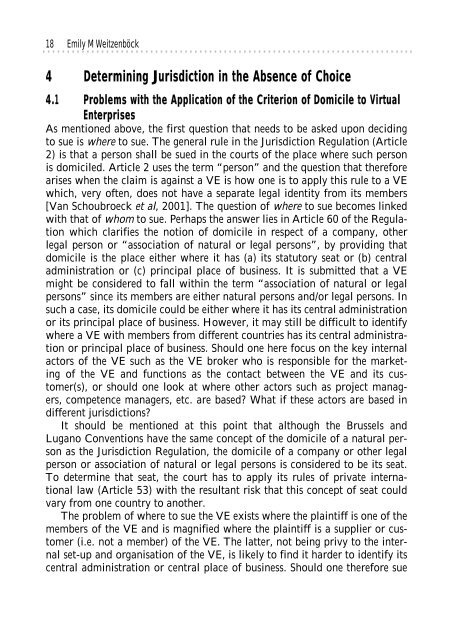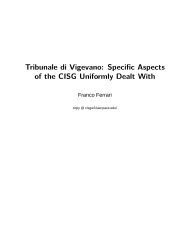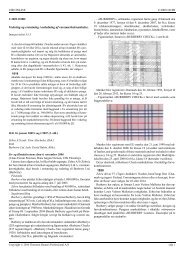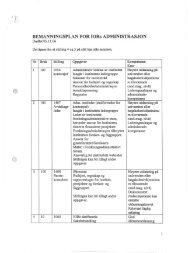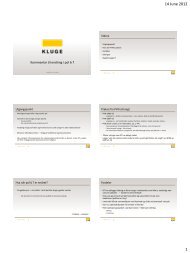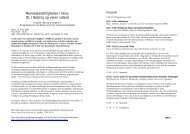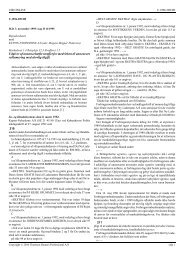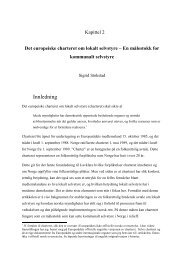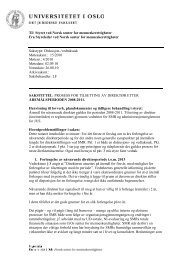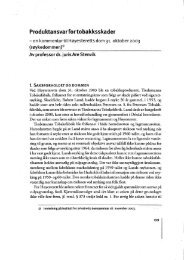Lee A. Bygrave (red.) YULEX 2002 - Universitetet i Oslo
Lee A. Bygrave (red.) YULEX 2002 - Universitetet i Oslo
Lee A. Bygrave (red.) YULEX 2002 - Universitetet i Oslo
Create successful ePaper yourself
Turn your PDF publications into a flip-book with our unique Google optimized e-Paper software.
............................................................................<br />
18 Emily M Weitzenböck<br />
4 Determining Jurisdiction in the Absence of Choice<br />
4.1 Problems with the Application of the Criterion of Domicile to Virtual<br />
Enterprises<br />
As mentioned above, the first question that needs to be asked upon deciding<br />
to sue is where to sue. The general rule in the Jurisdiction Regulation (Article<br />
2) is that a person shall be sued in the courts of the place where such person<br />
is domiciled. Article 2 uses the term “person” and the question that therefore<br />
arises when the claim is against a VE is how one is to apply this rule to a VE<br />
which, very often, does not have a separate legal identity from its members<br />
[Van Schoubroeck et al, 2001]. The question of where to sue becomes linked<br />
with that of whom to sue. Perhaps the answer lies in Article 60 of the Regulation<br />
which clarifies the notion of domicile in respect of a company, other<br />
legal person or “association of natural or legal persons”, by providing that<br />
domicile is the place either where it has (a) its statutory seat or (b) central<br />
administration or (c) principal place of business. It is submitted that a VE<br />
might be conside<strong>red</strong> to fall within the term “association of natural or legal<br />
persons” since its members are either natural persons and/or legal persons. In<br />
such a case, its domicile could be either where it has its central administration<br />
or its principal place of business. However, it may still be difficult to identify<br />
where a VE with members from different countries has its central administration<br />
or principal place of business. Should one here focus on the key internal<br />
actors of the VE such as the VE broker who is responsible for the marketing<br />
of the VE and functions as the contact between the VE and its customer(s),<br />
or should one look at where other actors such as project managers,<br />
competence managers, etc. are based? What if these actors are based in<br />
different jurisdictions?<br />
It should be mentioned at this point that although the Brussels and<br />
Lugano Conventions have the same concept of the domicile of a natural person<br />
as the Jurisdiction Regulation, the domicile of a company or other legal<br />
person or association of natural or legal persons is conside<strong>red</strong> to be its seat.<br />
To determine that seat, the court has to apply its rules of private international<br />
law (Article 53) with the resultant risk that this concept of seat could<br />
vary from one country to another.<br />
The problem of where to sue the VE exists where the plaintiff is one of the<br />
members of the VE and is magnified where the plaintiff is a supplier or customer<br />
(i.e. not a member) of the VE. The latter, not being privy to the internal<br />
set-up and organisation of the VE, is likely to find it harder to identify its<br />
central administration or central place of business. Should one therefore sue


